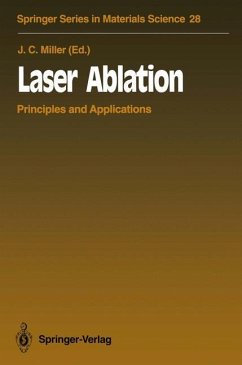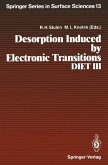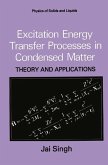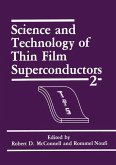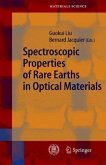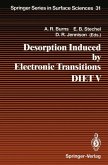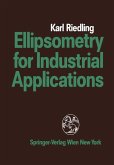Laser Ablation
Principles and Applications
Herausgegeben von Miller, John C.
Laser Ablation
Principles and Applications
Herausgegeben von Miller, John C.
- Broschiertes Buch
- Merkliste
- Auf die Merkliste
- Bewerten Bewerten
- Teilen
- Produkt teilen
- Produkterinnerung
- Produkterinnerung
Laser Ablation provides a broad picture of the current understanding of laser ablation and its many applications, from the views of key contributors to the field. Discussed are in detail the electronic processes in laser ablation of semiconductors and insulators, the post-ionization of laser-desorbed biomolecules, Fourier-transform mass spectroscopy, the interaction of laser radiation with organic polymers, laser ablation and optical surface damage, laser desorption/ablation with laser detection, and laser ablation of superconducting thin films.
Andere Kunden interessierten sich auch für
![Desorption Induced by Electronic Transitions, DIET III Desorption Induced by Electronic Transitions, DIET III]() Desorption Induced by Electronic Transitions, DIET III77,99 €
Desorption Induced by Electronic Transitions, DIET III77,99 €![Excitation Energy Transfer Processes in Condensed Matter Excitation Energy Transfer Processes in Condensed Matter]() Jai SinghExcitation Energy Transfer Processes in Condensed Matter77,99 €
Jai SinghExcitation Energy Transfer Processes in Condensed Matter77,99 €![Science and Technology of Thin Film Superconductors 2 Science and Technology of Thin Film Superconductors 2]() Science and Technology of Thin Film Superconductors 277,99 €
Science and Technology of Thin Film Superconductors 277,99 €![Spectroscopic Properties of Rare Earths in Optical Materials Spectroscopic Properties of Rare Earths in Optical Materials]() Spectroscopic Properties of Rare Earths in Optical Materials284,99 €
Spectroscopic Properties of Rare Earths in Optical Materials284,99 €![Desorption Induced by Electronic Transitions DIET V Desorption Induced by Electronic Transitions DIET V]() Desorption Induced by Electronic Transitions DIET V77,99 €
Desorption Induced by Electronic Transitions DIET V77,99 €![Optical Technologies in the Humanities Optical Technologies in the Humanities]() Optical Technologies in the Humanities75,99 €
Optical Technologies in the Humanities75,99 €![Ellipsometry for Industrial Applications Ellipsometry for Industrial Applications]() Karl RiedlingEllipsometry for Industrial Applications39,99 €
Karl RiedlingEllipsometry for Industrial Applications39,99 €-
-
-
Laser Ablation provides a broad picture of the current understanding of laser ablation and its many applications, from the views of key contributors to the field. Discussed are in detail the electronic processes in laser ablation of semiconductors and insulators, the post-ionization of laser-desorbed biomolecules, Fourier-transform mass spectroscopy, the interaction of laser radiation with organic polymers, laser ablation and optical surface damage, laser desorption/ablation with laser detection, and laser ablation of superconducting thin films.
Produktdetails
- Produktdetails
- Springer Series in Materials Science .28
- Verlag: Springer / Springer Berlin Heidelberg / Springer, Berlin
- Artikelnr. des Verlages: 978-3-642-78722-5
- Softcover reprint of the original 1st ed. 1994
- Seitenzahl: 204
- Erscheinungstermin: 8. Dezember 2011
- Englisch
- Abmessung: 235mm x 155mm x 12mm
- Gewicht: 318g
- ISBN-13: 9783642787225
- ISBN-10: 3642787223
- Artikelnr.: 36122384
- Herstellerkennzeichnung
- Springer-Verlag GmbH
- Tiergartenstr. 17
- 69121 Heidelberg
- ProductSafety@springernature.com
- Springer Series in Materials Science .28
- Verlag: Springer / Springer Berlin Heidelberg / Springer, Berlin
- Artikelnr. des Verlages: 978-3-642-78722-5
- Softcover reprint of the original 1st ed. 1994
- Seitenzahl: 204
- Erscheinungstermin: 8. Dezember 2011
- Englisch
- Abmessung: 235mm x 155mm x 12mm
- Gewicht: 318g
- ISBN-13: 9783642787225
- ISBN-10: 3642787223
- Artikelnr.: 36122384
- Herstellerkennzeichnung
- Springer-Verlag GmbH
- Tiergartenstr. 17
- 69121 Heidelberg
- ProductSafety@springernature.com
Laser Ablation discusses experiments and models for laser ablation of atoms, ions, molecules and clusters from solid surfaces. Specific topics include laser ablation and thin-film deposition of high-temperature superconductors; laser-induced desoption of adsorbed molecules and of semiconductors; laser ablation of polymers and biological tissues; laser desorption mass spectrometry of biological molecules; fundamental physics of ablation; and such diverse applications as tribological film deposition laser-ablation mass spectrometry in ion traps.
1. History, Scope, and the Future of Laser Ablation.- 1.1 Introduction.- 1.2 History of Laser Ablation Studies and Applications.- References.- 2. Electronic Processes in Laser Ablation of Semiconductors and Insulators.- 2.1 Electronic Mechanisms in Desorption and Ablation.- 2.2 Interaction of Photons with Solids.- 2.3 Electron-Lattice Interactions and the Localized Excited State.- 2.4 Creation and De-Excitation of the Localized Excited State.- 2.5 Survey of Experimental Results.- 2.6 Models of Laser-Induced Desorption.- 2.7 Simulation of Laser Ablation.- 2.8 Summary and Conclusions.- References.- 3. Laser Ablation and Optical Surface Damage.- 3.1 Introductory Remarks.- 3.2 Characteristics of Optical Surface Damage.- 3.3 Possible Causes of Optical Damage.- 3.4 Investigation of Optical Surface Damage Mechanisms.- 3.5 Concluding Remarks.- References.- 4. Pulsed-Laser Deposition of High-Temperature Superconducting Thin Films.- 4.1 Advantages of Pulsed-Laser Deposition.- 4.2 Materials Base.- 4.3 Laser-Beam-Target Interaction.- 4.4 Dynamics of the Laser-Produced Plume.- 4.5 Evaporant-Substrate Interaction.- 4.6 Frontiers of High-Temperature Superconducting Thin-Film Research.- 4.7 Scaling-up to Larger Areas.- 4.8 Future Directions.- 4.9 Summary.- References.- 5. Interaction of Laser Radiation with Organic Polymers.- 5.1 History.- 5.2 Characteristics of UV-Laser Ablation.- 5.3 Chemical Physics of the Ablation Process.- 5.4 Theories of Ultraviolet-Laser Ablation.- 5.5 Contemporary Trends in UV-Laser Ablation.- References.- 6. Laser Ablation and Laser Desorption Techniques with Fourier-Transform Mass Spectrometry (FTMS).- 6.1 Principles of FTMS Operation.- 6.2 Laser-Ablation FTMS for Clusters.- 6.3 Laser-Desorption FTMS for Biomolecules.- 6.4 Future Directions.- 6.5 Conclusions.- References.- 7. Diagnostic Studies of Laser Ablation for Chemical Analysis.- 7.1 Laser Ablation in Vacuum.- 7.2 Laser Ablation in an Atmosphere.- References.
1. History, Scope, and the Future of Laser Ablation.- 1.1 Introduction.- 1.2 History of Laser Ablation Studies and Applications.- References.- 2. Electronic Processes in Laser Ablation of Semiconductors and Insulators.- 2.1 Electronic Mechanisms in Desorption and Ablation.- 2.2 Interaction of Photons with Solids.- 2.3 Electron-Lattice Interactions and the Localized Excited State.- 2.4 Creation and De-Excitation of the Localized Excited State.- 2.5 Survey of Experimental Results.- 2.6 Models of Laser-Induced Desorption.- 2.7 Simulation of Laser Ablation.- 2.8 Summary and Conclusions.- References.- 3. Laser Ablation and Optical Surface Damage.- 3.1 Introductory Remarks.- 3.2 Characteristics of Optical Surface Damage.- 3.3 Possible Causes of Optical Damage.- 3.4 Investigation of Optical Surface Damage Mechanisms.- 3.5 Concluding Remarks.- References.- 4. Pulsed-Laser Deposition of High-Temperature Superconducting Thin Films.- 4.1 Advantages of Pulsed-Laser Deposition.- 4.2 Materials Base.- 4.3 Laser-Beam-Target Interaction.- 4.4 Dynamics of the Laser-Produced Plume.- 4.5 Evaporant-Substrate Interaction.- 4.6 Frontiers of High-Temperature Superconducting Thin-Film Research.- 4.7 Scaling-up to Larger Areas.- 4.8 Future Directions.- 4.9 Summary.- References.- 5. Interaction of Laser Radiation with Organic Polymers.- 5.1 History.- 5.2 Characteristics of UV-Laser Ablation.- 5.3 Chemical Physics of the Ablation Process.- 5.4 Theories of Ultraviolet-Laser Ablation.- 5.5 Contemporary Trends in UV-Laser Ablation.- References.- 6. Laser Ablation and Laser Desorption Techniques with Fourier-Transform Mass Spectrometry (FTMS).- 6.1 Principles of FTMS Operation.- 6.2 Laser-Ablation FTMS for Clusters.- 6.3 Laser-Desorption FTMS for Biomolecules.- 6.4 Future Directions.- 6.5 Conclusions.- References.- 7. Diagnostic Studies of Laser Ablation for Chemical Analysis.- 7.1 Laser Ablation in Vacuum.- 7.2 Laser Ablation in an Atmosphere.- References.

